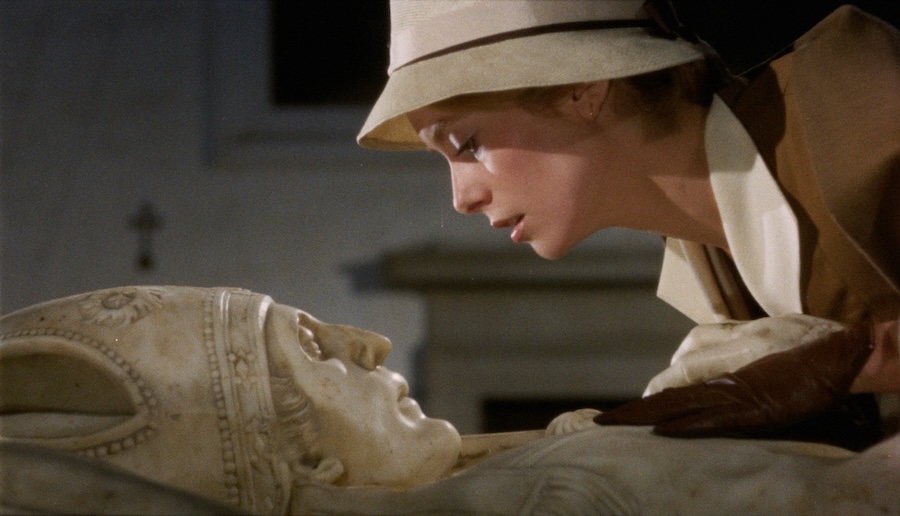
SOMEWHERE BETWEEN THE INNOCENT GIRL AND THE NOT SO INNOCENT MISTRESS IS THE BIZARRE, SENSUOUS STORY OF TRISTANA.

When Luis Buñuel wanted to turn Benito Pérez Galdós’s novel “Tristana” into a movie in 1962, his and Julio Alejandro’s script was rejected. The same thing had happened earlier in the year with another screenplay. It took six years until the project was revived, and what was to have been Buñuel’s great return to Spain after living in Mexico for many years became another protracted struggle with Franco’s censors. No wonder, because Tristana is true to the director’s style and themes.
A father-daughter relationship becomes something else
In 1920s Toledo, the 19-year-old Tristana (Catherine Deneuve) becomes an orphan when her mother dies and is adopted by the much older nobleman Don Lope Garrido (Fernando Rey). He is immediately attracted to her and it doesn’t take long for him to steal a kiss and turn their initial father-daughter relationship into something more sexually twisted. Tristana agrees to this arrangement, but a few years later she’s becoming more independent, leaving the house and going places without telling Don Lope. She falls in love with an artist her age, Horacio (Franco Nero), and prepares to leave Toledo with him.
Don Lope is unable to put up much resistance, although he pathetically tries to challenge his young rival to a duel. However, the old man is surprisingly drawn into Tristana and Horacio’s lives again at a later stage…
Much in common with the director
This classic has become one of Buñuel’s most highly praised, even earning an Oscar nomination, but it isn’t as shocking as certain parts of Belle de Jour (1967). That’s not to say that Tristana is tame. One of its most memorable visuals is the girl having frequent nightmares involving Don Lope where his decapitated head has replaced the rope of a church bell that keeps ringing.
Religion is an obvious theme in the film. Interestingly, Don Lope remains a very unflattering human being in spite of the fact that he has things in common with the director. He’s an atheist, shunned by his deeply religious sister, and despises the bourgeoisie and how they, in his opinion, walk all over decent, common workers. Since Don Lope himself belongs to the upper middle class and behaves very much like one of them, there is much contradiction in this character. He’s growing old but refuses to acknowledge it, dying his beard black, spouting sexually liberated views and approaching young women as if age doesn’t matter at all; at the same time, his attitude toward Tristana is very stern and paternal.
Catherine Deneuve and Fernando Rey are equally magnificent in their roles.
The attacks on the Catholic Church that Buñuel levels through Don Lope must have been enough to irritate censors, but the story as a whole, where improper lust and exploitation is followed by bitterness and malice as Don Lope gets his comeuppance, cannot have been easy to swallow. Still, in the end maybe the censors became too absorbed to demand more concessions from the filmmakers. Tristana also stages fascinating clashes between youth and old age and mirrors a frustration likely felt by disabled persons, symbolized by a deaf-and-mute boy and Tristana’s subsequent destiny. Deneuve and Rey are equally magnificent in their roles; Nero really takes a backseat.
At the time of Belle de Jour, Buñuel said that it would be his last film. Considering the fact that he went on to make a few more great dramas, such as this one and The Discreet Charm of the Bourgeoisie (1972), we should all be thankful that he found inspiration somewhere.
Tristana 1970-France-Spain. 99 min. Color. Directed by Luis Buñuel. Screenplay: Julio Alejandro, Luis Buñuel. Novel: Benito Pérez Galdós. Cinematography: José F. Aguayo. Cast: Catherine Deneuve (Tristana), Fernando Rey (Don Lope Garrido), Franco Nero (Horacio), Jesus Fernandez, Lola Gaos, Vincent Solder.
Trivia: Co-produced by Buñuel.
Last word: “Personally, I’m monogamous and discreet. An old man can easily make a fool of himself. Like Don Lope in Tristana, I believe in a chaste eroticism. You can attribute that to my Jesuit education. Sexual pleasure for me is directly linked with the idea of sin and only exists in a religious context. The sexual act cannot be reduced to a chapter on hygienics; it is an exciting, dark, sinful, diabolical experience. Sex is a black tarantula and sex without religion is like an egg without salt.” (Buñuel, The New York Times)
